I woke up in the research tower to a soft exhale and then a trickle of water at the waterhole below. The full moon hung low and dim in the west. I squinted at my watch. It was 4 A.M. I wondered which of my elephant study subjects had come to drink at this hour. Elephants are creatures of habit, and they typically don’t show up here at the Mushara waterhole in Namibia’s Etosha National Park until at least 11 A.M. But the full moon does funny things to elephant movements.
I rolled over in my sleeping bag to look out at the visitors. Two bulls stood at the source of the spring, drinking quietly. The older one was facing sideways, and the younger one had his back toward me. Focusing my binoculars on the edges of their ears, I could see a telltale tab on the left ear of the older one and two sharp cuts on the right ear of the younger one. It was Abe and Andries.
My team and I had been following the older bull, Abe, since 2004 and Andries since 2011. Abe hadn’t visited Mushara for the entire 2024 field season, and here he was in all his glory, his tusks having grown out nicely after breaking a few years ago. I was glad to see him, not only because I enjoyed observing his endearing patience with younger males but also because he was one of my most important study subjects.
On supporting science journalism
If you’re enjoying this article, consider supporting our award-winning journalism by subscribing. By purchasing a subscription you are helping to ensure the future of impactful stories about the discoveries and ideas shaping our world today.
Abe was an integral member of a social group whose behavior I had been focused on documenting for years. African elephants have matriarchal societies, in which elder females lead families made up of their female relatives and young to water, food and safety. Most of what we know about elephant social behavior has come from studies of these female-led family groups. Males, in contrast, leave their family group as they reach adolescence and go off to live as bachelors. Historically, little research was conducted on the social dynamics of adult male elephants because they were thought to be largely solitary. It seemed safe to assume their social lives were simple, with none of the complex rules and rituals seen in the family groups.
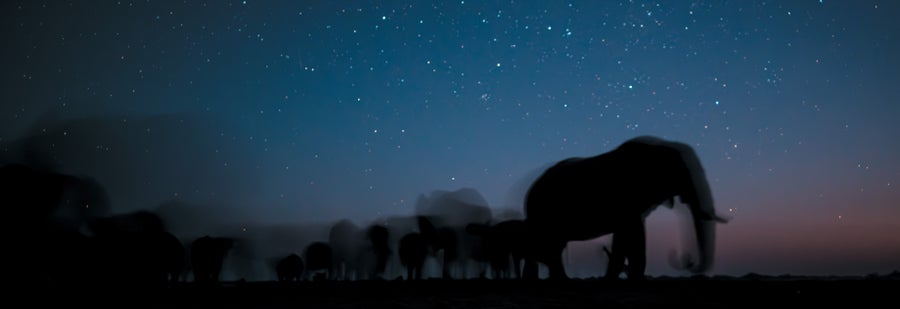
When young male elephants visit the waterhole with their families, they get to interact with bachelor males and learn who they can trust when the time comes to set out on their own.
Caitlin O’Connell and Tim Rodwell
But research that I and other scientists have been carrying out is finally starting to fill this gap in our understanding of elephant behavior. Our long-term observations of Abe and the other males who have visited Mushara over the past two decades reveal that male elephant societies have incredibly intricate rules, rituals and hierarchies of their own.
Male elephants, we are learning, are sensitive social animals that crave companionship and need emotional support. Their experiences of growing up parallel those of human males, who undergo similar social changes and pressures as they enter the adult world—from backslapping in the bar, to defending another’s honor by taking on a bully, to being best friends forever. Having a social network of other trusted males may be important for navigating the transition to adulthood.
These findings indicate that this highly intelligent species is even more socially complex than we previously understood it to be—and could inform vital efforts to manage and protect these animals in the wild and in captivity.
One of our most exciting discoveries concerns vocal communication. Researchers have long known that female African elephants use vocalizations to coordinate group behavior. In family groups gathered at a water source, a dominant female, usually the matriarch, will step away from the water, align herself toward the direction she wants to leave in and then rumble a call to action—“Let’s go!”
It’s understandable why families would engage in this behavior. Coordinating a group of 20 to 40 or more elephants isn’t a simple task. Using a vocal tool to call the group into line is well documented in other species, too. Among gorillas, for example, one ape’s grunt triggers another to grunt, and another and another, until consensus is reached and all leave the area together. The same is true of wild dogs, who sneeze to reach consensus about departure. But whether male elephants, with their looser group structure, engaged in similar vocal coordination was unclear.
I suspected based on a handful of observations that the male elephants were indeed communicating in this way, but I needed a larger sample to prove the pattern was real. The male elephants that congregate at Mushara tend to be most vocal at night, which also happens to be when conditions are best for recording their sounds. And so I found myself working the late shift during our field seasons, timing my observation sessions to when the bachelors were chattiest.
Recently my collaborators and I published a paper containing the fruits of this labor. We were able to show that when a group of male associates leaves the waterhole, one of the core members of the group flaps his ears gently while emitting a long, low rumble—the “let’s go” signal. In turn, the others respond with their own rumble while following the instigator away from the water, each waiting for another to finish their call before contributing their own say in the matter. The paper marks the first time such coordination has been documented in male elephants, as well as the first time vocalizations have been shown to trigger action within male groups.
When I first witnessed groups of bonded males engaging in this kind of vocal ritual, I got really intrigued. Why would these males want to leave together? Unlike the family groups, in which the dominant females who determine the group’s movements are acting in the interests of their close relatives, male elephants have traditionally dispersed far from their natal group. This arrangement meant that they were often not related to the other males with whom they associated.
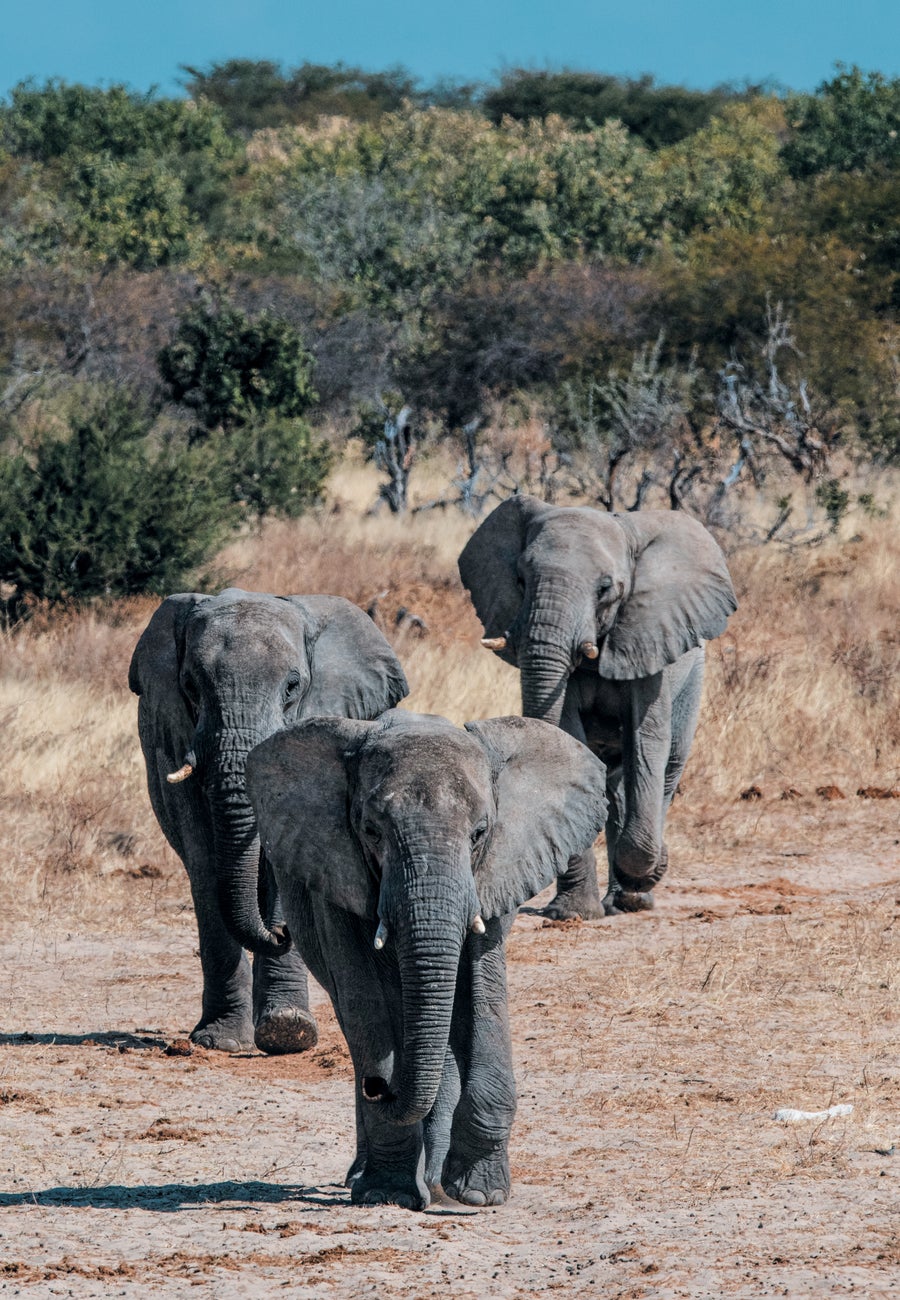
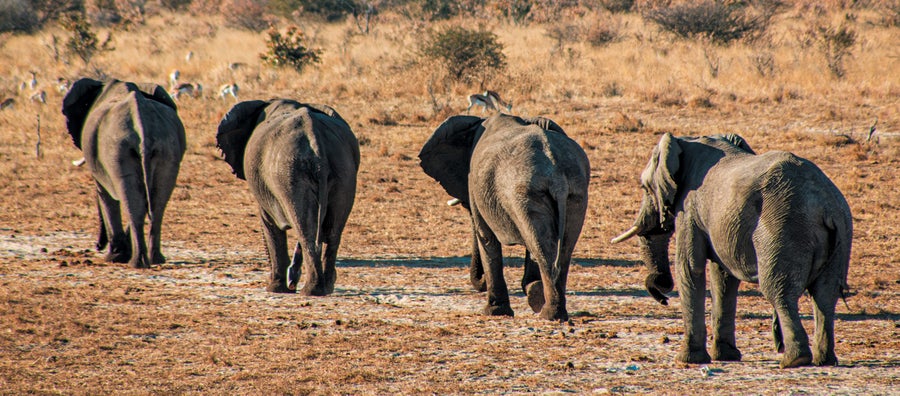
Bonded males arrive at the waterhole together using vocal coordination (top). Such groups also coordinate their departure this way. After a socially connected male initiates the “let’s go” rumble, the rest of the group members take turns rumbling their assent as they walk away together (bottom).
Caitlin O’Connell and Tim Rodwell
Leaving together implies they’ll be sharing resources at their next destination. I had seen powerful older males shake full-grown acacia trees to make the seed pods—a favorite food of elephants—shower down to the ground. On some of these occasions a younger bull or two came in to sample the spoils. Usually established group members would shove chancers away from the prized pods, but they tolerated ones who had arrived at the invitation of the older male. There had to be some advantage to older males inviting younger males to join them in their travels.
Why would older males want to share with younger associates when they didn’t have to? What advantage was there in staying together? Could these males want the companionship even if it meant sharing? Did male elephants form even tighter-knit groups than previously thought? Our observations of vocal coordination among the Mushara males sparked many such questions. Studies of other aspects of their behavior have led to some answers.
To the untrained eye, the most obvious ritual exchange between male associates is what we call the greeting. A younger individual often initiates the greeting, placing the tip of his trunk either within or just at the entrance to the mouth of a buddy or an older male. The greeting is typically reciprocated—unless the recipient is very high-ranking. In that case, the gesture is more like a salute of one or more individuals to a general or a kiss of a royal’s ring.
Beyond the greeting, the behind-the-scenes decorum in male engagement is so fine-tuned it’s like the list of steps for having tea with the queen. We can look at the ritual of play for another example. For male elephants, play is important for building trust and developing skills needed to compete for mates later in life. Our data show that individuals of all ages within a bonded group of male elephants solicit play with other individuals in equal amounts. More often than not, however, younger elephants must wait until the older one initiates the play bout, regardless of which one solicited it.
Such conventions are hallmarks of a very sophisticated society. Each ritual helps to reinforce the rules of engagement within the group, thus strengthening bonds. This is all very much in keeping with what we already know about elephant intelligence, long-term memory, empathy and sense of self based on studies of the female-led family groups. What’s new and surprising here is that we’re documenting these group dynamics in males, who were long thought to be mostly solitary. And not only do we see rituals in these male groups, but the groups also engage in behaviors indicative of a hierarchical social structure.
In our study of vocal coordination triggering group action, we described, for the first time, a case of active leadership in male elephants. An active leader is one who solicits others to follow him and exerts social influence through means of dominance ranks, social position or experience. In contrast, passive leadership might occur when an older individual is followed by an uninvited youngster. In these situations, the older individual often signals his displeasure by turning around and shaking his head. This response usually deters unwanted companions, but it depends on how determined the younger one is.
My colleagues and I got our first inkling of male leadership in the Mushara social club back in 2004. A dominant bull we named Greg seemed to call the shots. Long conga lines of males of all ages and sizes followed Greg in and out of the waterhole. He was beloved by his underlings and either feared or revered by many of his contemporaries and elders. He led with a carrot-and-stick style—forgiving of the transgressions of youngsters but hard on his contemporaries.
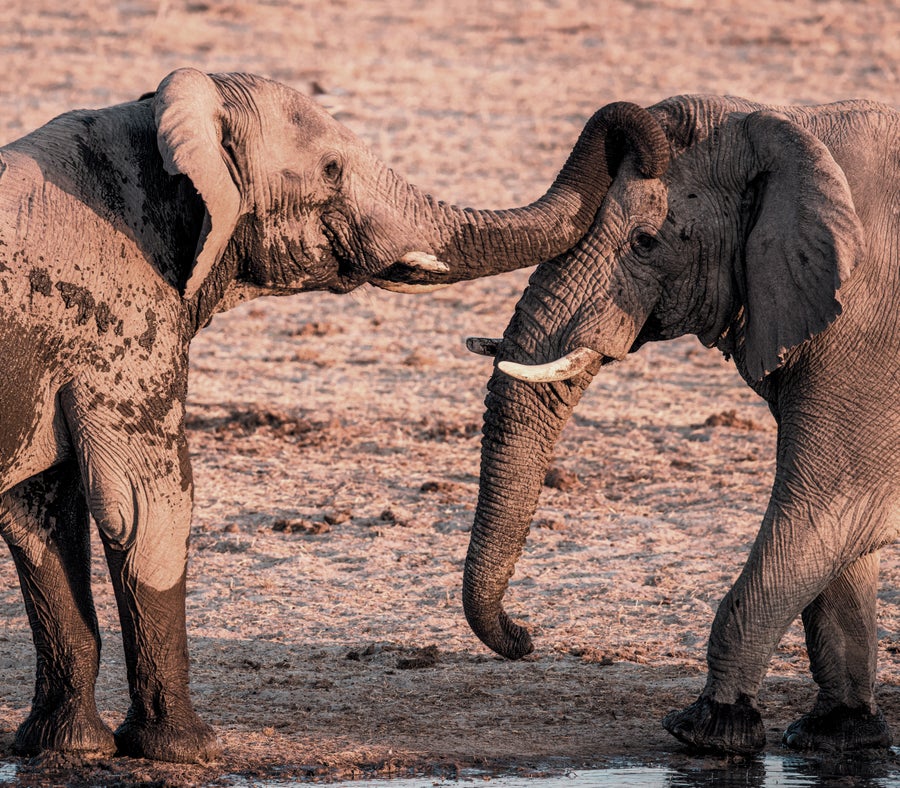

Two males bond at the waterhole. Bachelor males of all ages benefit from socializing with other males. Such interactions can lead to lifelong companionship.
Caitlin O’Connell and Tim Rodwell
When Greg decided it was time to depart Mushara, he would stop drinking, turn in the direction he planned to go and invite the others to leave with a “let’s go” rumble. His message elicited synchronized, ritualized rumbles from the rest of the group. On occasion Greg would give some of the youngest ones a gentle shove to expedite any deliberations.
The simple act of inviting others to leave with him showed that Greg and males like him, who are socially connected, actually make an effort to keep the group together. This behavior is news because leadership in male social groups is not a given in mammals. Take the olive baboon, for example. A dominant male baboon has seemingly no interest in leading his underlings. His primary interest is in securing the best resources for himself, mates and food included. It’s the female baboons who do the leading.
Over the years, as I observed Greg and the other males at the Mushara, I thought about why male elephants might come together in these groups and coordinate their actions. Forming coalitions could be one explanation. Ritualized vocal coordination could solidify and reinforce bonds the elephants needed to work together to intimidate or push off rival males. An unwanted individual could suddenly find himself facing a wall of imposing elephant ears, held up high like battle shields. It would be a lot easier to gain access to the best resources as a group than for an individual to defend them on his own. And considering that the Mushara waterhole was one of only three water points in the region, it was a vital resource to defend.
Despite this obvious benefit, I couldn’t help wondering whether there were other factors in play. Perhaps there was a reproductive advantage for older males who adopted the emotionally needy underlings.
In a previous era, when elephants were free to roam in an environment unobstructed by fences built by humans, male elephants left their natal families during their coming-of-age testosterone spikes and were thought to settle far from their genetic line. This dispersal pattern maintained the diversity of the elephant gene pool, and it implied that males found socializing together were not related. But the realities of modern Africa are such that elephant movements are often impeded by human activity, and young males can’t move as far away from their families as they might have in the past.
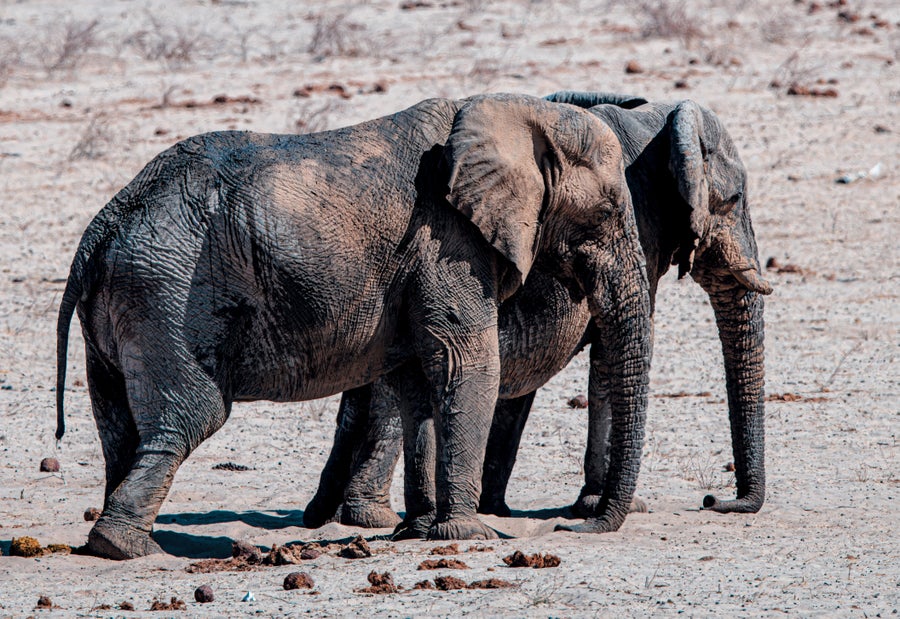
Older male Abe (front) and younger male (back) listen for the arrival of their companions.
Caitlin O’Connell and Tim Rodwell
This ecological shift increases the odds that a bachelor will encounter his male relatives on the landscape after dispersing from his natal group. If males within bonded groups were in fact related to one another, their genetic line would have a better chance of getting passed along if older males could help ensure that their relatives survive and reproduce.
Many species, such as mice, can smell related individuals and hence avoid inbreeding. It occurred to me that male elephants might have a similarly innate ability to recognize relatives. If so, a father elephant might be able to identify his offspring through olfactory cues and choose his companions accordingly. In fact, another recent study by my team indicates that male elephants track one another over space and time in a way that could be achieved only through olfaction and possibly vocalizations. We found evidence that males remotely monitor one another’s locations and move toward or away from other elephants depending on their social relationships. (Similarly, adult males find mates by listening for the distinctive calls of estrus females and smelling olfactory cues in their urine.)
We are still studying the relatedness of individuals in these bachelor groups. Future findings may shift our understanding of whether, by associating in these groups, males are acting to maximize their ability to reproduce and pass their genes to the next generation. There may be additional factors to consider as well. Another advantage of keeping a group together is companionship. Younger males, who are still struggling to adjust socially to life outside a huge family, certainly benefit from older males who can model good behavior.
Older males may gain from this association, too. In another recent study we conducted on male elephant character, we showed that adult males profit psychologically from the companionship of younger males. We collected behavioral data from 34 individually known males at Mushara over a five-year period and found that the presence of young males in a group reduces aggression and increases affiliative, or friendly, behavior in older males. Male elephants of all ages need socialization just like any other social animal. They seek interaction and bonding from youngsters, contemporaries and elders they can look up to.
Given how important bonded groups are to elephants, I never would have expected that the structure of male elephant society was vulnerable to collapse. But after our 2011 fieldwork season at Mushara, Greg disappeared. I anticipated a scramble for power. Instead we witnessed a complete destabilization of the social club. Greg’s absence ushered in an era of small factions; no one took up his leadership torch. Not even his best buddy, the well-respected Abe, stepped up.
Abe just didn’t seem to have the titanium stomach required to rule, which was understandable. Being at the top is a lot of work—always having to posture, appeasing the youngsters while signaling dominance to one’s ever-watchful upwardly mobile contemporaries, facing the threat of being toppled by a potentially mortal blow at any moment. Yet somehow Greg was able to do it with surprisingly little stress, according to his cortisol profile, which we assessed by collecting and analyzing his feces over the years.
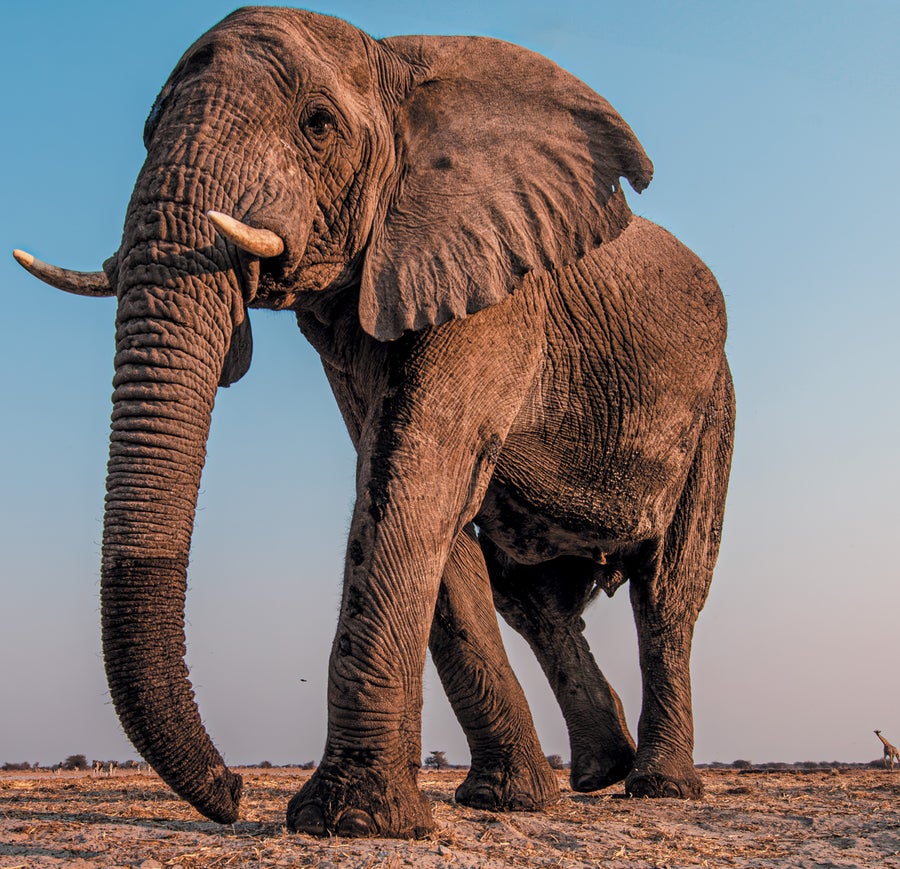
Young adult male Shaka, shown here back in 2011, now displays signs of active leadership and may one day become the leader of the social club at Mushara.
Caitlin O’Connell and Tim Rodwell
Some 14 years after Greg’s disappearance, the Mushara males remain leaderless. But there are prospects. Young adults Kelly and Shaka have shown signs of wanting to mentor the next generation. They have allowed younger males to explore their faces and tusks, place tentative trunks in their mouths and hang a trunk on their tusk. They have even permitted two youngsters to hang their trunks on their tusks, one on each side, while Kelly and Shaka try to drink.
I’d give anything to know what these young males are thinking in these moments of exploration and seeming admiration of the grown-ups. Puberty is a traumatic period of uncertainty for these youngsters. For a male that has grown up within a tight-knit elephant family, it’s a big social adjustment to live outside the family. He is not accustomed to isolation. Companionship is all he knows. I suspect that any ritual of connection would give a young male a sense of belonging—whether it be a secret handshake or tolerance from an elder. Acceptance goes a long way toward easing the transition to adulthood.
It takes a certain kind of male character to have patience with these youngsters—and to take up the mantle of leadership. He has to have all the right stuff. According to our recent character study, the right stuff seems to be a combination of self-confidence and a sense of decorum that gains the confidence of the group. Leaders tend to be the most socially integrated members of the group, not necessarily the most dominant.
After an older male allows young males to explore his face and body with their inquisitive trunks, the next sign that he has an interest in mentorship is the act of inviting these younger males to join him as he departs the waterhole. I can tell from the perky posture of the young males who receive such an invitation that they understand exactly what it means—that they have been accepted into the most important social club of their lives, where membership could last a lifetime.
I eagerly await these moments of active leadership. The more we understand about the complexities of male elephant society, the better we will be able to protect and manage this species. All our recent findings and the findings of others further speak to the social nature of male elephants. This work has implications for wild, captive and semicaptive males. For example, people who manage captive elephants might be able to improve their welfare by putting the males in mixed-age groups and organizing these groups around older males who have demonstrated leadership potential. Likewise, efforts to manage elephant populations in the wild ought to factor in the importance of postreproductive bulls to coming-of-age males. Not only does their presence keep younger males, with their raging hormones, from becoming too aggressive, but they also contribute to the younger males’ sense of belonging.
Now every time I hear a male “let’s go” rumble exchange, I jump out of my sleeping bag and turn on the sound recorder and the night vision scope. I quickly document who is involved in the exchange—who initiated and who responded and when. These observations give me hope for a return to the good old days at Mushara, when the group thrived under Greg.
All too soon after Abe and Andries finally showed up at the waterhole last year, they set off again. As I watched them head south, Abe flapped his ears, and Earth’s largest land animal emitted the lowest-frequency vocalization on the planet. It was the “let’s go” rumble—the invitation to accompany him. It was the call that Abe had so often enjoyed responding to but rarely initiated himself. With a little pep in his stride, Andries answered the call to action with an equally long and low response.
I rolled over and tucked myself back into my sleeping bag for just a little while longer. In an hour the camp would be a buzz of activity to pack up and leave. The Mushara field season had ended, and I was grateful for Abe’s appearance, even if only in the final hours of my stay. It gave me peace of mind to know he was still out there. I was also glad to see Shaka and Kelly, the next generation after Abe, offering new coming-of-age males safe harbor.
The sound of the “let’s go” duet faded. I imagined Abe and Andries saying to each other, “If you go low, I’ll go high!” as they harmonized and disappeared into the bush, bound for their next destination in good company.

